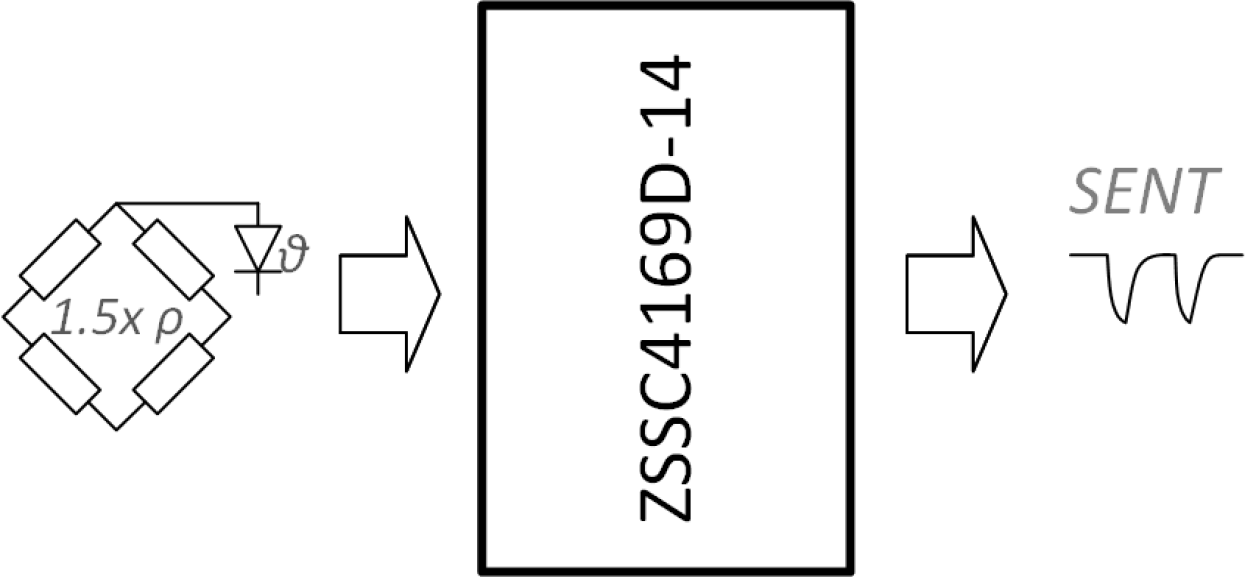特性
- 差分电桥传感器输入和片上或外部温度传感器,可选择调节传感器输入信号和/或温度输出
- 扩展的温度测量选项(即内部传感器、外部二极管)
- SENT 接口;用于校准的 OWI 或 I²C 选项
- 对被测传感器输入信号的失调、增益和高阶非线性以及温度系数进行数字补偿
- 工作温度范围:-40°C 至 150°C
- 精度:-40°C 至 125°C 时为 ±0.50% FSO
- NVM 存储器,用于存储配置数据、用户可配置的测量、调节功能以及用户选择的数据
描述
ZSSC4169 是 IDT ZSSC416x 系列 CMOS 集成电路的产品,用于对差分桥传感器信号进行高精度放大和传感器特定校正。 ZSSC4169 的最大前置放大范围为 150 至 200,几乎适用于所有电阻电桥以及电压源传感器类型。 失调、灵敏度、温度漂移和非线性的数字补偿由一个 16 位 RISC 微控制器完成。 校准系数和配置数据存储在集成的非易失性存储器(NVM)中,这在汽车应用中非常可靠。 测量值可以通过数字 SENT 读取。 SENT 接口仅使用一个输出引脚即可通过其快速通道传输传感器数据,并通过其串行数据消息(“慢速”)通道传输补充数据。 通过 I²C 接口或通过单线接口(OWI)通过数据输出引脚(DOUT)支持下线校准。 ZSSC4169 和校准设备可进行数字通信,因此噪声灵敏度大大降低。 数字校准有助于保持较低的装配成本,因为不需要外部设备或修整。 ZSSC4169 通过过压和反极性保护电路、出色的电磁兼容性和多种诊断功能针对汽车环境进行了优化。
产品参数
| 属性 | 值 |
|---|---|
| Function | Resistive SSC |
| Automotive Qual. | Yes |
| Supply Voltage (V) | 4.5 - 5.5, 4.75 - 5.25 |
| Input Type | Single-bridge, Single-Bridge, Temperature Diode |
| Interface | SENT, I2C |
| Adj. Analog Gain | 2.1 - 200 |
| Resolution (bits) | 14 |
| Sample Rate Max (KHz) | 0.66, 1.3 |
| Temp. Range (°C) | -40 to +150°C, -40 to 150°C |
当前筛选条件
筛选
软件与工具
样例程序
模拟模型
Modern vehicles are filled with complex sensor systems to achieve optimal performance and lower emissions. IDT's (acquired by Renesas) ZSSC416x and ZSSC417x family of sensor signal conditioner ICs are ideal for use in the engine and exhaust system. Sensing differential pressure at the mass airflow intake using a single IC attached to two sensors lowers power consumption and improves accuracy compared to traditional sensing systems. Manifold pressure and temperature sensing also benefit from using a dual input IC, with higher accuracy measurements resulting in a more optimal fuel mix.
The IDT ZSSC416x and ZSSC417x family of sensor signal conditioners provide a platform for measurement systems with improved accuracy, reliability, and performance with lower power consumption. The family of devices provides highly accurate amplification with integrated compensation, correction, and calibration, while also sharing a common four-millimeter by four-millimeter QFN package and toolset to reduce development and assembly costs.
Related Resources
ZSSC416X and ZSSC417X provide highly accurate amplification and calibrated correction of sensory data for resistive bridge and voltage source sensors. The family features SENT 3.0-based ICs and is designed for use in automotive applications. With available diagnostic info, rugged circuit protection, and excellent electromagnetic compatibility.
The family aids designers by lowering power consumption, reducing component count, and saving time spent calibrating sensors. Additionally, the availability of dual-bridge inputs also reduces system complexity and footprint. All of these are important considerations in modern automotive applications where power and space come at a premium.
Related Resources
SENT (Single Edge Nibble Transmission) is a unique serial interface/protocol originally targeted for automotive applications. Engineers are using this interface with sensors for applications such as throttle position, pressure, mass airflow, and high temperature. IDT provides sensor signal conditioners that function using the SENT interface.
The video reviews the three main SENT transmission protocols: fast channel read, short serial message format, and enhanced serial message format. It will cover the SENT signal's basic terms, definitions, and abbreviations, what is required to decode the SENT signal, and how to determine which SENT format applies to each application. It will cover the advantages of a SENT output vs. analog output and show an example of a sensor interface using SENT 3.0.
Related Resources
A brief introduction and overview of IDT's (acquire by Renesas) sensor signal conditioner evaluation kits. Evaluation kits generally consist of three parts: a communication interface board, a device board, and a sensor simulator board - all connected together. A sophisticated software GUI accompanies the kit, enabling an engineer to learn how to use the part rapidly, do quick prototyping, and practice calibrations.
Presented by David Grice, applications engineer at IDT. For more information about IDT's sensor signal conditioner products, visit the Sensor Signal Conditioner page.

